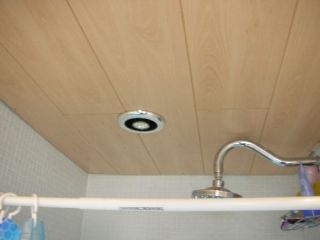Ceilings can be difficult to make look good and so in the last few years cladding has become popular. Here we are going to clad a ceiling in an ensuite bathroom.
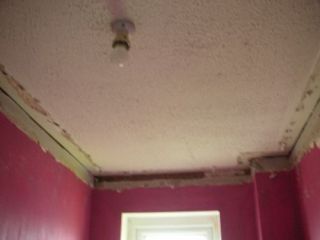
This is the bathroom with the old coving removed, you can see that there is a single light fitting in the centre of the room and there is considerable making good to be done before we can continue.
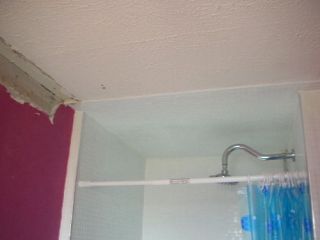
The shower area has had the ceiling tiled in glass mosaic tiles and so this area is about 8mm lower than the artexed part of the ceiling. The height of the shower means that I could not fit a false ceiling and lower it beneath the coving and that is why the coving had to be removed.
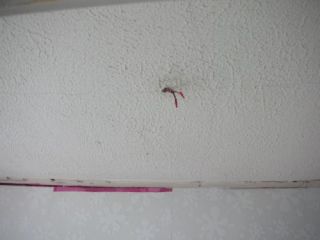
The first thing we need to do is to remove the light fitting. To do this isolate the electricity at the fuse box and then when you are 100% certain that it is isolated you can remove the fitting and tape the wires individually. Please read the article on Safe isolation procedures
The walls have been made good and some have been wall papered. From underneath I have marked pencil lines where the joists above are and this will make it much easier to fasten up the frame for the cladding.
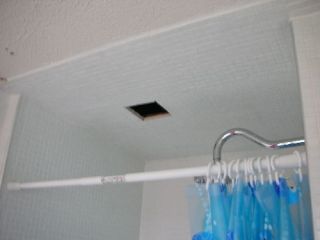
Because the tiles in the shower area are mosaic glass I have been in the loft and determined where the extractor fan needs to be situated and I have cut out a square using a plasterboard saw, by cutting in the grout lines. Goggles are a must when doing jobs of this nature!
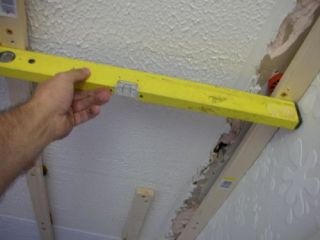
The battens that we are using are 75mm *19mm. The battens need cutting to length and then require fastening to the ceiling. The firs batten has been fixed at the tiled end as this is the lowest point on the ceiling, as we move away from the tiled section we need to pack behind the battens and then screw them to the joists above.
Use a spirit level to ensure that the battens are level when fixing. You can either use single battens or you can use double battens. If you use double battens you lower the ceiling by an extra 19mm and also considerably increase the ventilation between the old ceiling and the cladding.
The more ventilation the better in rooms containing showers! We will be using double battens and so we will batten in one direction opposite to the direction of the joists and then batten on top of the first battens going in the opposite direction of the first battens.
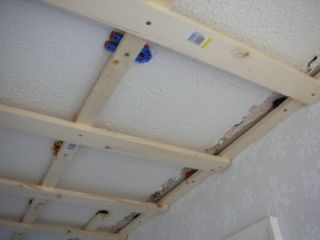
Here you can see that the second row of battens cross the first row and so the ventilation is greatly improved. You can also see the large amount of packing shims that were required in order to level the ceiling. The cladding will specify the maximum distance between the battens, which in this case is no more then 1200mm centres.
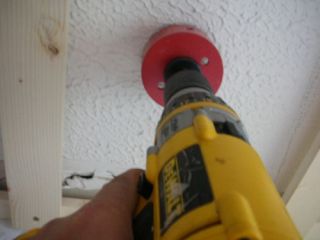
Before continuing any further you need to mark out the position of the downlighters (if you intend fitting them). You must check above to ensure that there is no wires or pipes in the way.
Drill the holes using the correct size hole saws and ensure that you wear the goggles again. It is a good idea to plan your ceiling so that the lights avoid the need to drill through joists etc.
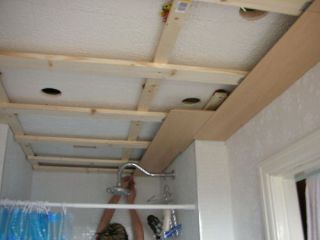
Once the ceiling has been battened out you can start to fix the cladding. This cladding is fixed with special clips that fit in the groove side of the cladding and so the first piece should be fitted with the tongue side facing the wall.
This can be screwed at the edge as the beading will cover this later. Screw a screw through the cladding and into the battens ensuring that you leave an expansion gap as recommended by the manufacturer, which in this case is 8mm.
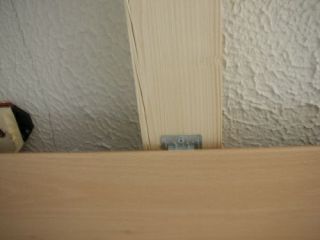
Here you can see that this clip is holding up the groove side of the board. The clips slide into place and are then screwed into position using small screws.



